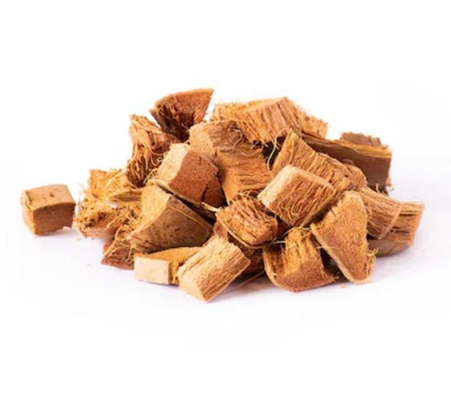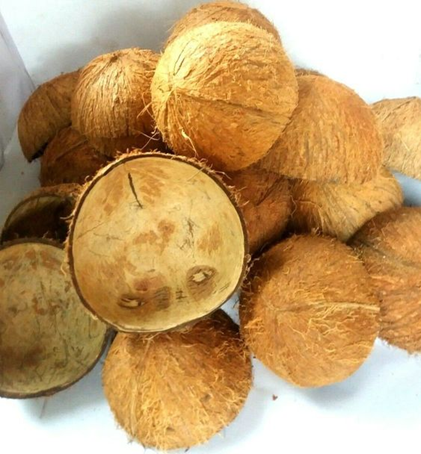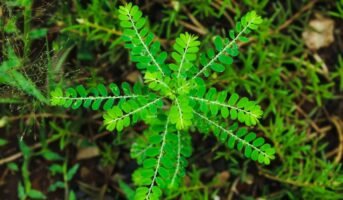The rough outer shells of the coconut are known as coconut husks. While the husks, like the meat and liquid found within the exterior shell, are not used for food, they can be used to make enriched potting soil and as chips to provide ground cover for flower beds. It is possible to buy mass-produced husk products or make them at home using fresh coconut shells.
The procedure for husking a coconut at home is relatively simple. All you need is a fresh coconut and a long stick with one end sharpened to a point. The stick’s opposite end must be firmly planted in the ground, with the sharpened end pointing straight up. This establishes the foundation for removing the husk.
Coconut husk: How to husk a coconut?
- The coconut should be firmly grasped in both hands before being slammed upon the sharpened stick’s point to start the husking process.
- By performing this movement, the coconut husk can be punctured, and a tiny portion of the outer husk can be lifted.
- You should use one hand to peel the loosened husk off the coconut body and continue doing so until the husk is completely gone.
- Once the husk has been removed, it is simple to use sharp knives to create chips suitable for use in flower beds and gardens.
- The chips work similarly to other popular types of ground cover, such as pine straw, in that they aid in maintaining the moisture and capacity of the underlying ground to provide nutrients to developing plants.
- Because it is a natural element, it will decompose over time and enrich the soil.

Source: Pinterest
Coconut husk: How are coconuts husked in a factory?
- In a factory, machinery holds the coconuts in place while sharpened points work the husks loose.
- The meat and milk of the coconut are then used to make a variety of food products, while the husks are routed to other facilities and ground into a fine texture that mixes well with various types of potting soil.
- The nutrients in the husk make it an excellent natural additive to potting soil products, and it works well with all types of houseplants as well as potted tomato and bell pepper plants.
- Typically, coconut husks are used to improve potting soil or as an efficient ground cover for little plants in the garden.
- The husks can also be used to make a variety of folk-art items, such as masks, simple but decorative boxes, and even imaginative picture frames.

Source: Pinterest
Coconut husk: Uses
There is a wide range of applications and uses of coconut husk. Some of these include:
Coconut husk: Uses in manufacturing of various products
Coconut husk has a high capacity for producing a variety of important products for the modern market. Coco peat, coco husk chips, coco crush, and coir fibre are just a few of the products made from the outer shell of the coconut fruit. Iis used to make potting material for growing plants and flowers. Coconut husk fibre called coir is frequently used to make doormats and brushes. It is also used to make twine, particle board, and sustainable packing material, and it is even used in mattresses and floor tiles.
Coconut husk: Uses in farming and gardening
Coconut husk has the ability to absorb nutrients and deliver them to the plant consistently. Coconut husk decomposes quickly and provides beneficial soil enrichment to plants. It is primarily used as a plant growing medium (potting medium) for flowering plants such as orchids and roses. It has the ability to keep moisture inside, allowing plants to grow healthier. Coconut husk chips, which are small ‘chips’ of coconut husk that resemble garden mulch, serve as a popular planting medium that can be used instead of peat to help plants retain moisture and resist fungal growth.
Coconut husk: Uses in cleaning
Coconut husk serves as an amazing tool for cleaning utensils. Its strands are segregated and mixed with lemon juice and charcoal powder to create a cleaning pad. These scrubbing pads form an exceptional eco-friendly cleaning alternative. In addition to being comfortable to use, these coconut husk cleaning pads have good water retention capability, are recyclable, and do not smell.
Coconut husk: Uses as an alternative fuel source
Coconut husk can be converted into an alternative fuel source, which can replace other traditional sources of fuel like wood. When it comes to the cost and availability of coconut husks, there is much potential for using the husk of coconut as a fuel source in power plants.
Coconut husk: Uses as a natural exfoliant for skin
Coconut husks also have great applications in the beauty and skincare domain. It serves as a gentle exfoliator and helps in lightly clearing out dead cells from the skin’s surface. Coconut husk exfoliator draws out bacteria, chemicals, poisons, dirt and other micro-particles to the surface to clean skin of all impurities from within.
Coconut husk: Uses as an air freshener
In many Indian households, a traditional method to combat odours involves using coconut husk in a brass mug. Camphor is added to the husk and ignited, effectively eliminating unpleasant smells in the kitchen and home. This practice also serves as a natural mosquito repellent.
See also about: Coco peat
Coconut husk: Environmental and economic impact
According to estimates, 95% of the 50 billion coconuts grown around the world are owned by approximately 10 million farmers who earn less than Rs 160 per day on average.
The concept of converting waste into resources can be a game-changer for this industry. The successful adoption of these new composite materials in markets could significantly increase — and in some cases, double — the annual income of coconut farmers, transforming families and communities.
The environmental impact is also significant. According to some studies, switching to coir, or fibres made from coconut husks, can cut carbon dioxide emissions by 450,000 tonnes annually and petroleum usage by 2 to 4 million barrels.
Right now, India and Sri Lanka are the primary producers of coir, accounting for roughly 90% of total production. However, because Indonesia and the Philippines are the top coconut producers, there is a significant opportunity to bring coir production to that region as well.
Advantages of using coconut husk as a raw material
By utilising all parts of the coconut, producers ensure sustainable harvesting and production processes, preventing deforestation and reducing CO2 emissions. Natural glues extracted from coconuts eliminate the need for chemical agents and lower production costs. Coconut waste is inexpensive, biodegradable, and easily decomposed, benefiting soil health. This approach also supports farmers in developing countries by providing additional income and promoting global development goals. Collaborating with local companies, developed countries can obtain sustainable raw materials while contributing to the economic well-being of coconut-producing regions.
FAQs
Why is it necessary to soak coconut husk in water before planting?
In order to reduce the stiffness of the raw coconut husk, a small amount of coconut husk is taken and kept in water.
Can coconut husk be consumed?
Coconut husk is not eaten, but it is used to make potting material for growing plants and flowers.
What is the chemical makeup of coconut husk?
Cellulose, lignin, pyroligneous acid, gas, charcoal, tar, tannin, and potassium are the main components of coconut husks.
Housing News Desk is the news desk of leading online real estate portal, Housing.com. Housing News Desk focuses on a variety of topics such as real estate laws, taxes, current news, property trends, home loans, rentals, décor, green homes, home improvement, etc. The main objective of the news desk, is to cover the real estate sector from the perspective of providing information that is useful to the end-user.
Facebook: https://www.facebook.com/housing.com/
Twitter: https://twitter.com/Housing
Email: [email protected]











